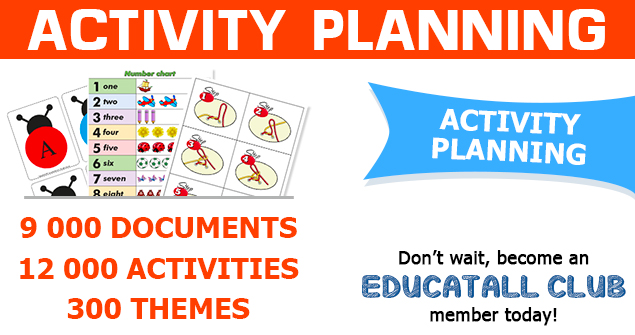
18 months to 2 ½ years of age
An early childhood educator sent me a question about managing a group of toddlers. I decided to share my response with you, since this type of question is common among those who work with children in this age group.
Hello Chantal,
My name is Inji. I work in a daycare nursery. My group is made up of 10 children between the ages of 18 months and 2 years old. I am having difficulty capturing children's attention when it's time for activities that are to be done at the table, painting or stickers for example.
In general, children love these activities, but there are a few hyperactive children in my group. As soon as one of them leaves the table, the others follow. What's more, if one child starts making noise at the table, they all follow suit. In the same way, if a child starts running within the daycare, before long they are all running in every direction. Of course, this also applies to climbing, swinging on a chair, pushing, and biting.
Because of my temperament and personality, I try to gently explain to them that they cannot act this way in a daycare setting, but they simply turn away and ignore my requests. Of course, this upsets me and I therefore lose control.
Please help me!
Inji
Hello Inji,
It is common for early childhood educators to say that this age group (18 months to 2 ½ years of age) is difficult. Some even believe that the behavior of children in this age group resembles the opposition present in the teenage years. For many, it is difficult to understand how and why these adorable babies suddenly begin biting, hitting, climbing, and, most of all, not listening.
Here are a few things to consider.
Discovering new surroundings
A baby's initial role (0-15 months) is to discover. Although young babies are unable to move about, they explore their surroundings: their daycare and their home. They also learn to get to know their parents and their early childhood educator. At first, this is sufficient. They feel safe.
Once they learn to walk, they become curious little explorers. By then, they are far too familiar with their immediate environment. They are ready to meet other people. To fulfill this desire, they must acquire autonomy and self-confidence. At this age, they don't seem to stay in the same spot very long, they have so many things to explore. This explains their need to move and climb. Sitting in the same spot represents a waste of time.
Discovering others
To socialize more, they need to discover new people. A neighbour, for example, can suddenly become very interesting. A child this age may even cross the street without looking to see if a car is coming just to meet a neighbour.
Nonetheless, establishing contact with others is challenging for children in this age group, mainly because they are still in the parallel play stage. Understanding the feelings of others is difficult, but children feel the need to express themselves. This explains why, for example, a child may bite another child to express that he doesn't want him to touch his toy.
A few suggestions for working with toddlers
Repetitive but important interventions
With this age group, early childhood educators are constantly repeating the same rules and instructions: "Be gentle.", "Use your words.", "Say please.", etc.
Early childhood educators must also name children's feelings, for example by saying, "Are you angry because he took your toy? Tell him you don't like that he took it from you!"
Using positive statements is important. This means you should say, "We walk in our daycare." instead of "We don't run in our daycare."
Motor skills
Create activities that will provide children with the opportunity to be active several times per day. Plan activities that involve jumping, climbing, running, etc. If your daycare is very big, children will be tempted to run around since they have a strong need to be active. Move your furniture items around to create barriers and delimit smaller areas. One large open space is too inviting for little runners with lots of energy. Take your group outside as often as you can. Make use of a long hallway, create obstacle courses, have children play with balls and tunnels, or invite them to dance.
Playing through imitation
As you mentioned in your letter, children of this age are big fans of imitation. They will mimic the actions and behaviors of others, good or bad. That is how they learn. Keep in mind that toddlers understand things by copying the world that surrounds them.
Tapping on a table produces a sound that is interesting. They therefore want to imitate the child who thought of it. When this happens, providing drums may fulfill children's need to make noise. Encourage them to move about and invite them to execute various actions and gestures to the sound of the music. In the same way, if you see a cat, you can suggest they stretch like it or make meowing sounds. Anything and everything can be used to create new activities.
Short attention span
Children this age are unable to remain seated at a table for very long. Is it because they aren't really interested in the activities you are offering? Are the activities adapted to their capacities? Do they simply have a strong need to get up and move? Keep in mind that children in this age group have a very short attention span. Do not expect them to remain seated for more that 5 minutes, 8 minutes at the very most. Change up your activities often to keep children interested. If that doesn't work, simply move on to your next activity.
Small-group activities
Expecting a group of ten children to sit at a table and all take part in the same activity is possible with a group of four-year-olds, but not with a group of toddlers. Because they are still at the parallel play stage, it is next to impossible for them to enjoy such an activity. Instead, offer free play opportunities alongside an activity that is to be enjoyed at the table. Those who wish to participate in your activity will join you at the table. Your curious explorers will enjoy playing with modeling dough, drawing with crayons, tearing paper, etc. Don't even think about presenting cute arts & crafts models, children in this age group aren't ready for them. Painting requires a great deal of supervision and preparation. Ask yourself if it's an activity that is appropriate for a group of ten children.
A little note for you: I hope you don't care for 10 toddlers alone... You should be at least two adults for 10 children. In Quebec, the ratio is one early childhood educator for eight 18-month-olds. Personally, I think the ideal ratio is one early childhood educator for six children. If you are two adults, you can easily divide the group a few times each day. One adult can offer an activity in your daycare room or class while the other adult can offer a different activity in the hallway or another available room.
Organizing your daycare
Be sure to offer a wide range of toys the children in your group can explore, making sure you have just enough for everyone. If you provide too many toys, you will constantly be picking them up. However, you could create several toy bins, filling each one with just a few items. For example, you could have one toy bin containing large blocks, a toy car bin, a plastic dishes bin, etc. When the bins are put away, they mustn't be within children's reach. Make only one bin available to your group at a time. When children seem less interested in the contents of a bin, put it away and set a new bin on the floor. If, for example, you provide a bin filled with balls, make sure you have at least one ball for each child. A lack of material will inevitably lead to conflicts.
A few activities that are sure to please this age group
It is a good idea to have a few activities that are sure to please the children in your group up your sleeve. You can use them on more difficult days to change children's focus.
- Duster and dustpan sets.
- Tiny bags containing objects or illustrations that can be hidden. Children will enjoy emptying and filling the bags as they explore the contents.
- Simple costumes children will be able to put on independently, hats for example. Be sure to provide a mirror.
- Physical activities such as lightweight scarves and music.
- With supervision, feathers can be used to tickle each other or tossed up in the air.
- Musical instruments.
- Different drawing activities (on a wall, on the floor, in a hallway, outside, etc.).
In conclusion, patience and organization are necessary when you work with this age group. Some days will be more exasperating than others... but there's always tomorrow!
Chantal Millette
Early childhood educator

 Home
Home Theme activities
Theme activities
 Babies and toddlers
Babies and toddlers
 Arts and crafts
Arts and crafts
 Science
Science
 Creative recipes
Creative recipes
 Tips and tricks
Tips and tricks
 Special needs
Special needs
 Extra activities
Extra activities
 Educ-TV
Educ-TV
 Newsletter
Newsletter  Online store
Online store Educatall club
Educatall club

